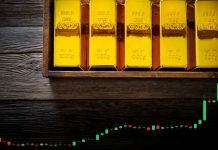Other than a nice 7% jump in Chinese property stocks following an apparently explosive weekend of home sales in Chinese big cities like Beijing and Shanghai amid the relaxed mortgage rules deployed by the government last week, we didn’t have much on our plate yesterday. European trading volumes were down by almost a third below their 30-day average and the major European indices were slightly down, as neither Friday’s jobs optimism in the US, nor the Chinese rebound on property news could help Europeans forget about their own slowing economies and sticky inflation, which probably require at least one more rate hike from the European Central Bank (ECB). The DAX remained offered near its 50 and 100-DMA, as the Stoxx 600 closed yesterday’s session below its own 50-DMA. Americans coming back from their long weekend, after the latest data showed a sweet loosening in US jobs market last month, could add some optimism to the mix, but the topside in European stock markets remains limited.
There is one place on the old continent, however, where the stock market looks more promising, is the UK. The British FTSE 100 – which clearly lagged its continental European and American peers so far this year, is looking in a better place to outperform in the H2, because of its high exposure to energy and mining stocks. The FTSE 100 has potential for a further rise toward 7650 then to 7800 level.
Activity in FTSE futures hints at a bearish start today.
In the FX
The EURUSD remains offered below its 200-DMA today, although the softening Federal Reserve (Fed) expectations make more sense than softening ECB expectations, provided that the ECB is NOT in a comfortable place to call a pause at this month’s meeting amid the uptick in latest inflation figures. Therefore, if the ECB expectations, which may have softened unnecessarily are restored into the next ECB meeting, we should see the EURUSD find a solid ground before the critical 1.0615 Fibonacci support.
On the flip side of the world, the Reserve Bank of Australia (RBA) kept its cash rate unchanged at 4.1% at today’s monetary policy meeting. The EURAUD rebounded from a month-dip as investors saw opportunity to trade the soft RBA stance versus a possibly unfunded softness in ECB expectations, which justifies a further upside correction in the EURAUD toward the 1.70 mark – especially when the news from China remains disquieting.
Elsewhere in the Pacific, Japan is testing the market demand for its 10 and 30-year bonds this week, as the finance ministry sells 2.7 trillion-yen worth of 10-year bonds today and 900-billion-yen worth of 30-year bonds on Thursday. Of course, the Bank of Japan (BoJ) is out and buying a massive amount of bonds to make sure that the YCC not too relaxed, and traders are looking for signs of still sluggish demand from local investors that could force the BoJ to act earlier than … never. The Japanese 10-year yield is currently at a 9-year high, but is still below 65bp, meaning that it has ways to strengthen. However, when the Japanese yields will become interesting enough for domestic Japanese investors – which are also among the biggest buyers of US papers, the returning home will apply a decent pressure on the US long term yields.











